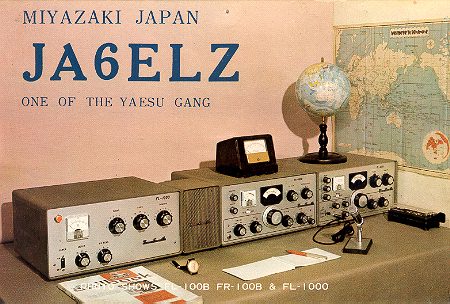Sako Hasegawa, JA1MP, established Yaesu Musen Company during 1959
His first SSB Equipment had been manufactured under the General Television Co Ltd name in 1957. Sako Hasegawa's ambition appears to have been to design and manufacture modern HF single sideband equipment for the amateur radio and SWL
| Frequency range: | 0.1-1300 MHz (Cellular blocked in the US) |
| AM (10 dB S/N) 0.1-5 MHz: 1.5 uV 5-370 MHz: 1 uV AM / FM / WFM / SSB / CW https://www.rigpix.com/yaesu/vr500.htm |
Yaesu had initially been formed with the intention to develop and manufacture commercial and amateur radio transceivers for the Japanese market, but only five years after its formation the company had signed foreign sales agreements for export to Australia and Germany.
In Europe, the equipment was sold under the Yaesu brand and the Sommerkamp brand. In 1963 the Swiss firm Sommerkamp imported Yaesu equipment and sold it using their own brand.
Yaesu's line of equipment was first imported into the US by Spectronics, Inc. located in Signal Hill, California, in 1965. Yaesu became an important presence in the U.S. amateur radio market with the introduction and improvement of its very popular FT-101 line of equipment in the 1970s. In addition, transceiver manufacture was outsourced to Henry Radio in Los Angeles.
Sako Hasegawa (JA1MP) died in 1993. Following his death, Jun Hasegawa took over as managing director.
Yaesu Musen acquired the STANDARD radio equipment brand from Marantz Japan in 1998 and changed the company name to Vertex Standard Co., Ltd. (株式会社バーテックススタンダード, Kabushiki-gaisha Bātekkusu Sutandādo) in 2000. In 2007, Motorola announced its intention to purchase 80% of Vertex Standard and form a joint venture with Tokogiken (a privately held Japanese company controlled by Jun Hasegawa), which would hold the other 20%. This deal was completed in January 2008.[2] The joint venture was dissolved effective January 1, 2012. The Vertex Standard land mobile division operates as a wholly-owned subsidiary headquartered in Tokyo, Japan.[3] The Amateur Radio, Airband and Marine Radio business was transferred to the new company "Yaesu Musen".[4]
- FR-50(B) (HF amateur band receiver)
- FR-101 (HF amateur band receiver)
- FRdx-400 (HF amateur band receiver)
- FRdx-500 (HF amateur band receiver)
- FRG-7 (HF communications receiver)
- FRG-100 (HF communications receiver)
- FRG-7000 (HF communications receiver)
- FRG-7700 (HF communications receiver) – An HF receiver for the radio amateur and for the commercial market. It is a metal-cased receiver with a polymer front and it is suitable for reception in the AM, FM, CW and SSB modes. Its frequency coverage is from 150 kHz – 30.0 MHz continuously in 30 switchable band segments. Its frequency readout is available in a traditional analog (dish) mode as well as in a digital display mode.[6] Called a “budget receiver”, the FRG-7700 was released in 1978 as successor to the FRG-7000 and priced at approximately US$450. This type was in production until 1982.[7] The FRG-7700 is a superheterodyne type receiver going up to 48 MHz in the Intermediate Frequency trap, followed by a fully synthesized local oscillator in the 1st and 2nd mixer unit and thus creating a VFO that is reasonably stable after warm-up.[8][page needed][9][page needed]
- FRG-8800 (HF communications receiver)
- FRG-9600 (VHF/UHF receiver/scanner)
- VR-120 (Hand-held wideband communications receiver)
- VR-500 (Hand-held wideband communications receiver)
- VR-5000 (Base wideband communications receiver)













.jpg)



.jpg)



Aucun commentaire:
Enregistrer un commentaire
Please indicate in your comment your amateur radio callsign, swl, or your email
Remarque : Seul un membre de ce blog est autorisé à enregistrer un commentaire.